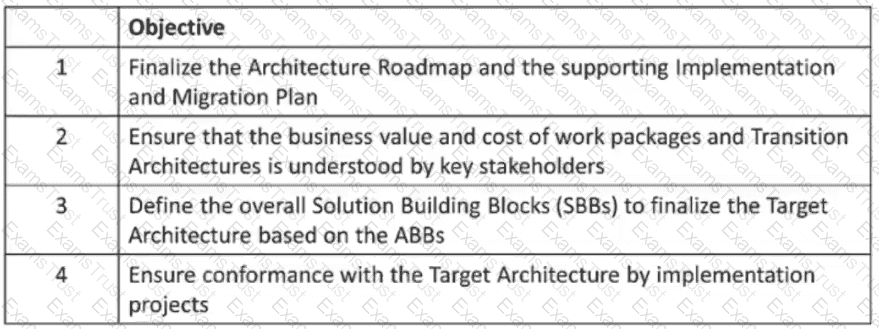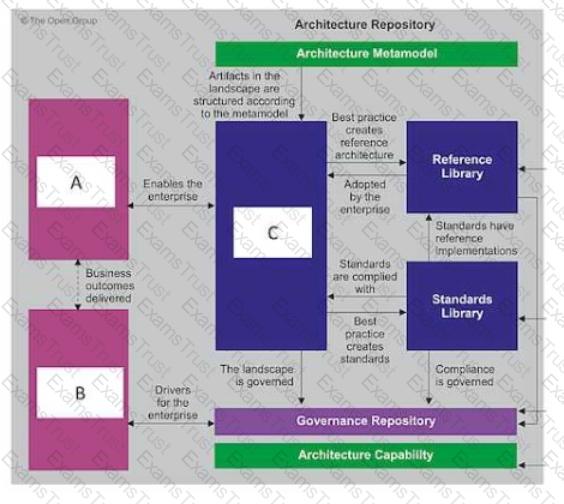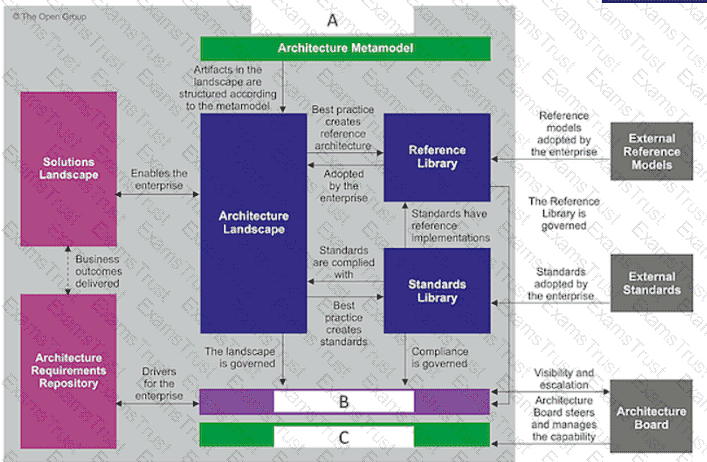Complete the sentence. When considering agile development, Architecture to Support Portfolio will identify what products the Enterprise needs, the boundary of the products, and what constraints a product owner has; this defines the Enterprise's
What are the four architecture domains that the TOGAF standard deals with?
Consider the following ADM phases objectives.

Which phase does each objective match?
Which of the following statements about architecture partitioning is correct?
When considering the scope of an architecture, what dimension is about the extent of the enterprise?
Consider the following statements:
1. Each contracted party is required to act responsibly to the organization and its stakeholders.
2. All decisions taken, processes used, and their implementation will not be allowed to create unfair advantage to any one particular party.
3. Digital Transformation and operations will be more effective and efficient.
4. Strategic decision-making by C-Level executives and business leaders will be more effective.
Which statements highlight the value and necessity for Architecture Governance to be adopted within organizations?
What structural framework does the TOGAF Standard define to support the management, leverage, and storage of architectural work products?
What is an objective of the ADM Implementation Governance Phase?
Consider the following statements about Architecture Partitioning:
The TOGAF ADM requires a partitioning model for architecture development
Architectures are partitioned when different teams need to work on different elements of the architecture at the same time
Partitions can be used to facilitate architecture re-use
Which statements are correct?
Which of the following statements about architecture partitioning are correct*?
1 Partitions are used to simplify the management of the Enterprise Architecture
2 Partitions are equivalent to architecture levels
3 Partitions enable different teams to work on different element of the architecture at the same time.
4 Partitions reflect the organization's structure
What ensures that a project transitioning into implementation also smoothly transitions into appropriate Architecture Governance?
Which of the following best describes the purpose of the Architecture Roadmap?
Consider the following statement:
According to the TOGAF Standard a governed approach of a particular deliverable will ensure a system of continuous monitoring to check integrity changes decision-making and audit of all architecture-related activities
Which deliverable is being referred to?
What are the following activities part of?
• Initial risk assessment
• Risk mitigation and residual risk assessment
• Risk monitoring
Complete the following sentence. In the ADM, documents which are under development and have not undergone any formal review and approval process are called______ Documents which have been reviewed and approved are called ______
What are the following activities part of?
. Risk classification
. Risk identification
. Initial risk assessment
Which of the following is a responsibility of an Architecture Board?
Which of the following statements about architecture partitioning are correct?
It is equivalent to architecture levels.
It enables different groups of architects to own and develop specific parts of an architecture.
It is implemented following a generally applicable partitioning model.
It is used to simplify the management of an Enterprise Architecture.
Which statement best summarizes the TOGAF Content Framework?
Complete the sentence When considering agile development Architecture to Support Project will identify what products the Enterprise needs the boundary of the products and what constraints a product owner has. this defines the Enterprise's___________.
Consider the illustration.

What are the items labelled A B and C?
Which of the following describes a purpose of Architecture Principles?
Consider the following extract of the purpose of an ADM Phase:
Phase Output & Outcome / Essential Knowledge
? — “A set of work packages that address the set of gaps, with an indication of value produced and effort required, and dependencies between the work packages to reach the adjusted target.”
What ADM Phase is this?
Complete the sentence The TOGAF standard covers the development of four architecture domains. Business. Data, Technology and__________________.
Complete the sentence The Architecture Landscape is divided into levels known as__________________________.
What is presented as ”striking a balance between positive and negative outcomes resulting from the realization of either opportunities or threats?
What is the purpose of the Preliminary Phase?
Consider the following ADM phases objectives.
Which phase does each objective match?
In the ADM, what is the name for documents that are not finished and not approved?
Complete the sentence The purpose of the Preliminary Phase is to_____________.
Exhibit
Consider the illustration showing an architecture development cycle Which description matches the phase of the ADM labeled as item 2?
Consider the following ADM phases objectives:
Ensure that the business value and cost of work packages and Transition Architectures is understood by key stakeholders
Ensure conformance with the Target Architecture by implementation projects
Ensure that the architecture development cycle is maintained
Ensure that the Architecture Governance Framework is executed
Which phase does each objective match?
Exhibit:

Consider the illustration. What are the items labelled A, B, and C?
Complete the sentence A set of architecture principles that cover every situation perceived meets the recommended criteria of_______________
What component of the Architecture Repository represents architecture requirements agreed with the Architecture Board?
Which one of the following classes of information within the Architecture Repository would typically contain a list of the applications in use within the enterprise?
Which of the following describes the practice by which the enterprise architecture is managed and controlled at an enterprise-wide level?
What provides context for architecture work, by describing the needs and ways of working employed by the enterprise?
In which phase of the ADM cycle do building blocks become implementation-specific?
Which of the following best describes a purpose of the Gap Analysis technique?